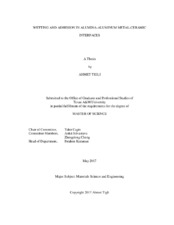| dc.contributor.advisor | Cagin, Tahir | |
| dc.creator | Tigli, Ahmet | |
| dc.date.accessioned | 2017-08-21T14:32:29Z | |
| dc.date.available | 2019-05-01T06:07:01Z | |
| dc.date.created | 2017-05 | |
| dc.date.issued | 2017-01-19 | |
| dc.date.submitted | May 2017 | |
| dc.identifier.uri | https://hdl.handle.net/1969.1/161296 | |
| dc.description.abstract | In this work, we investigate the thermal and mechanical properties of aluminum metal and alumina (α- Al2O3) ceramics by performing molecular dynamic simulation (MD) using two versions of reactive force fields (ReaxFF) for Al and Al2O3. We also use embedded atom model (EAM) potentials for the aluminum metal simulations. The MD simulations for thermal and mechanical properties are performed for different temperatures ranging from 0 to 1400 K and pressures ranging from 0 to 8 GPa. We also investigate the surface formation energy of solid aluminum and alumina for different temperatures. The surface formation MD simulations serve two purposes: first, to obtain the surface formation energies of aluminum and alumina using the EAM, ReaxFF potentials at different temperatures; and second, to acquire the relaxed alumina surfaces at the temperatures 700 to 1400 K in order to use the final atomic configurations of the wetting simulations as the initial structure of surfaces of alumina substrate.
The main result of this work is the investigation of the wetting and interface chemistry of molten aluminum droplets of the α-Alumina (0001) surface through MD simulations by employing the ReaxFF potentials. Wetting and interface chemistry are studied for different temperatures from 700 to 1400 K for four different droplet sizes: 16, 24, 32 and 40 Å diameters. Chemical reactions are observed at all temperatures and sizes in addition to diffusion between droplet and sphere atoms into each other during the wetting process. To define the level of wetting, we characterized contact angles of aluminum droplets on alumina substrates for all temperatures and sizes. We quantified the size and temperatures dependence of contact angle. Chemical reactions might be more effective for the small droplets 16 and 24 Å vs the bigger droplets 32, 40 Å due to the surface volume ratio of droplets. | en |
| dc.format.mimetype | application/pdf | |
| dc.language.iso | en | |
| dc.subject | wetting | en |
| dc.subject | aluminum/alumina interface | en |
| dc.subject | ReaxFF | en |
| dc.title | Wetting and Adhesion in Alumina-Aluminum Metal-Ceramic Interfaces | en |
| dc.type | Thesis | en |
| thesis.degree.department | Materials Science and Engineering | en |
| thesis.degree.discipline | Materials Science and Engineering | en |
| thesis.degree.grantor | Texas A & M University | en |
| thesis.degree.name | Master of Science | en |
| thesis.degree.level | Masters | en |
| dc.contributor.committeeMember | Srivastava, Ankit | |
| dc.contributor.committeeMember | Cheng, Zhengdong | |
| dc.type.material | text | en |
| dc.date.updated | 2017-08-21T14:32:29Z | |
| local.embargo.terms | 2019-05-01 | |
| local.etdauthor.orcid | 0000-0001-6611-6725 | |


